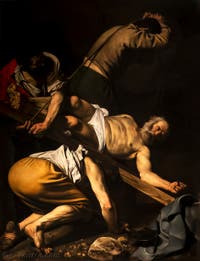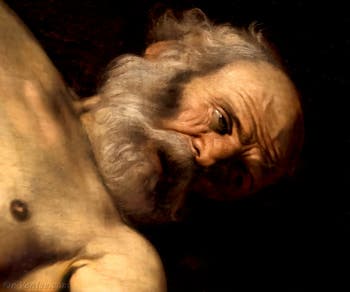Popolo Art History | Location | Opening Hours Tickets | Authorisations
Art History History | Cerasi | Caravaggio Peter | Caravaggio Paul | Chigi Borgia
Caravaggio “The Crucifixion of Saint Peter” at the Church of Santa Maria del Popolo
1602 - Oil on canvas, 2.30 m x 1.75 m
Caravaggio Crucifixion Sentenced to death by Agrippa, Saint Peter asked to be crucified like Jesus, but upside down to better show his attachment and submission to Christ.
Caravaggio's work depicts the executioners hoisting the cross, which spans the entire width of the canvas diagonally.
In this painting, revolutionary for its time, Caravaggio first shows the effort and fatigue of the men charged with crucifying the Saint, while Saint Peter himself, his hands and feet already nailed to the cross, stoically endures the pain.
Caravaggio depicts silence here.
Everything has already been done; all that remains is to raise the cross.

Caravaggio Crucifixion of Saint Peter The executioners are working hard, sweating, tired, bent over, carrying, pulling, anonymous figures carrying out their task without any compassion or emotion.
Three beasts of burden at work.
The rope digging into the back of one, while the tense muscles of the arms and swollen veins of the hands of the one with the furrowed brow helping to hoist the cross reveal the difficulty of the task.
These three crucify, each doing his part, while Saint Peter becomes a martyr.

Caravaggio Crucifixion of Saint Peter Saint Peter's face is turned towards his nailed hand, while his destiny is fulfilled as it should be.
Saint Peter looks on, his mind elsewhere, already illuminated by the Divine: I am leaving this world, follow me, he seems to say to the viewer.
We understand, we admetus that this is how things are, there is nothing more to be done.
The stone in the foreground recalls the words of Christ in the Gospel of Saint Matthew:
“You are Peter, and on this rock you will build my church.”
Art History History | Cerasi | Caravaggio Peter | Caravaggio Paul | Chigi Borgia
Popolo Art History | Location | Opening Hours Tickets | Authorisations
Back to Top of Page

